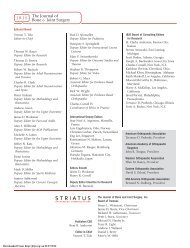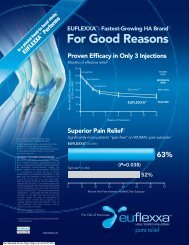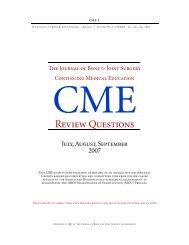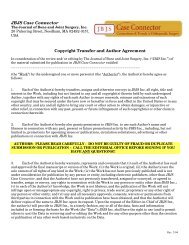Lower-Extremity Rotational Problems in Children - The Journal of ...
Lower-Extremity Rotational Problems in Children - The Journal of ...
Lower-Extremity Rotational Problems in Children - The Journal of ...
You also want an ePaper? Increase the reach of your titles
YUMPU automatically turns print PDFs into web optimized ePapers that Google loves.
Inter-exam<strong>in</strong>er variability was assessed by six exam<br />
<strong>in</strong>ers (the director <strong>of</strong> the orthopaedic departtiient. two or<br />
thopaedic residents. two medical students, and a pre<br />
medical student). Each <strong>of</strong> the six exam<strong>in</strong>ers measured the<br />
medial and lateral rotation <strong>of</strong> the hip. thigh-foot angle. and<br />
transmalleolar axis on the same three subjects (a twenty<br />
seven-month-old girl. an eleven-year-old boy. and a forty<br />
one-year-old woman). In addition, we compared the <strong>in</strong>ca<br />
surements made on the photographic negatives and dur<strong>in</strong>g<br />
20â€<br />
@ ., 0<br />
100<br />
0<br />
@100<br />
0<br />
LOWER-EXTREMITY ROTATIONAl. PROBlEMS IN (IIII.I)REN<br />
0<br />
0<br />
0<br />
@ 0<br />
P@,<br />
0<br />
0 a<br />
the cl<strong>in</strong>ical exam<strong>in</strong>ations. Cl<strong>in</strong>ical measurements <strong>of</strong> rotation<br />
<strong>of</strong> the hip were made with a gravity goniometer. and the<br />
thigh-foot angle and transmalleolaraxis were measured with<br />
a protractor. <strong>The</strong> standard deviations and mean errors for<br />
the photographic and cl<strong>in</strong>ical measurements are shown <strong>in</strong><br />
Table I. An F test <strong>of</strong> equality <strong>of</strong> variances <strong>of</strong> the photo<br />
graphic and cl<strong>in</strong>ical measurements showed no significant<br />
differences (p > 0.05). Thus. <strong>in</strong>ter-exam<strong>in</strong>er variabilities<br />
<strong>in</strong> the photographic and cl<strong>in</strong>ical measurements were similar.<br />
@ ,@bH@:<br />
@ 2SD<br />
@0<br />
±L.<br />
@ :@: . D<br />
0 0<br />
0<br />
0<br />
1 3 5 7 9 11 13 15-19<br />
a.<br />
0<br />
0 25D<br />
0<br />
0 0 Q ‘¿I<br />
1 3 5 7 9 11 13 15-19 30's 50's 70+<br />
0<br />
0<br />
a<br />
\<br />
0<br />
30's 50's 70+<br />
Figs. 2—Athrough 2—F:<strong>The</strong> five measurements plotted as the mean salites plus or tuititis Isoa stamdard deviations for each <strong>of</strong> the tsoentv-two age<br />
groups. <strong>The</strong> solid l<strong>in</strong>es show the mean changes with age: the shaded areas. the miormualranges: the solid circles. the mueamimeasuremilents for the different<br />
age groups: and the open circles. plus or m<strong>in</strong>us two standard deviations t@r the samiiemean miicasureniemits.<br />
Fig. 2-A: Foot-progression angle.<br />
80°<br />
60°<br />
40°<br />
VOL. 67-A, NO. I. JANUARY 19115<br />
0<br />
0<br />
Age (years)<br />
Fi. 2-A<br />
0@<br />
0<br />
Age (years)<br />
Fii@.2-B<br />
Medial rotation <strong>of</strong> the hip <strong>in</strong> male subjects.<br />
0<br />
0<br />
0<br />
2 SD<br />
2 SD<br />
41
















